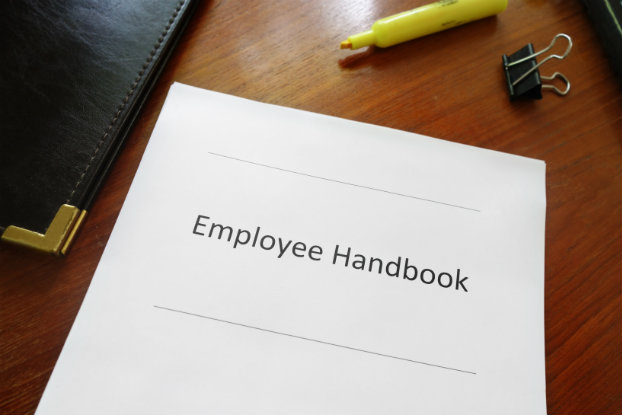Your company’s employee handbook is its first opportunity to communicate its values, culture, rights and expectations to employees, and it needs to cover all of these loaded topics in a friendly, straightforward and accessible manner. No small task.
In the event of a dispute between your company and one of its employees, the handbook may be used in court as evidence of an unfair or vague policy. By failing to include certain topics in an employee handbook, you can make it easy for your company to becomeentangled in a lawsuit, demanding time and money that would be better spent on the business.
Topics to Feature in Your Employee Handbook
A few general topics you should address in your employee handbook:
 Legal clauses regarding employee and company rights.
Legal clauses regarding employee and company rights. Day-to-day operational procedures.
Day-to-day operational procedures. Information about your company’s culture and history.
Information about your company’s culture and history.
The legal topics in your employee handbook:
 State laws governing workers’ compensation.
State laws governing workers’ compensation. Employee rights under the Family and Medical Leave Act of 1993 (FMLA).
Employee rights under the Family and Medical Leave Act of 1993 (FMLA). Anti-discrimination laws.
Anti-discrimination laws. At-will employment provision.
At-will employment provision.
Different jurisdictions have their own employee handbook requirements, and so businesses should familiarize themselves with applicable local, state and federal employment laws. If your company operates in multiple states, you might have to write multiple versions of the handbook to comply with each state’s laws.
Other topics relate to how your business operates on a daily basis:
 Compensation. A discussion of the payment schedule for each type of employee and the method by which employees are paid. This section should also have your company’s pay grade structure as well as work hours, overtime policy and bonus compensation.
Compensation. A discussion of the payment schedule for each type of employee and the method by which employees are paid. This section should also have your company’s pay grade structure as well as work hours, overtime policy and bonus compensation. Promotion Policy. Cover how the performance appraisal process works at your company and, if applicable, how an advancement schedule may operate.
Promotion Policy. Cover how the performance appraisal process works at your company and, if applicable, how an advancement schedule may operate. Employee Benefits. Provide a general overview of the healthcare and other employee benefits your company offers. Answer which employees are entitled to receive benefits, how they can modify their policies following a marriage or birth of a child, and when an employee may enroll in the benefits program.
Employee Benefits. Provide a general overview of the healthcare and other employee benefits your company offers. Answer which employees are entitled to receive benefits, how they can modify their policies following a marriage or birth of a child, and when an employee may enroll in the benefits program. Paid Time Off. Discuss how your company handles vacation and sick time for employees. This section should cover how much time off an employee is entitled to receive and any documentation required for using it.
Paid Time Off. Discuss how your company handles vacation and sick time for employees. This section should cover how much time off an employee is entitled to receive and any documentation required for using it. Employee Conduct. Cover employee meal and rest breaks, when employees should arrive and leave from work, company dress code and more. It can also include discussions of your company’s internet, email and social media policies; substance abuse policy; and handling of harassment complaints.
Employee Conduct. Cover employee meal and rest breaks, when employees should arrive and leave from work, company dress code and more. It can also include discussions of your company’s internet, email and social media policies; substance abuse policy; and handling of harassment complaints.
When creating a section on history and culture, your company handbook could perhaps use a short biography of its founder(s) and a timeline of company development. This gives newly hired employees a better understanding of the company and context for rest of the the rules in the handbook.
Topics to Leave Out of Your Employee Handbook
An employee handbook should serve as an informative guide to working at your company. It should not be used to push a specific agenda or set unreasonable expectations.
A few examples of topics that should be excluded from an employee handbook:
 Promises of job security. There is no way to know the future.
Promises of job security. There is no way to know the future. Requirements that infringe on an employee’s right to religious or other freedoms.
Requirements that infringe on an employee’s right to religious or other freedoms. Policies that lock management into specific courses of action. For example, a blanket discipline policy that leaves no opportunity for management to consider a situation’s circumstances.
Policies that lock management into specific courses of action. For example, a blanket discipline policy that leaves no opportunity for management to consider a situation’s circumstances.
Your Employee Handbook Is as Important to You as It Is to Your Employees
Before putting your employee handbook into circulation, have an employment attorney or trusted HR advisor read through it and note any ways the language can be modified to better comply with the law and protect your business.
For help with creating an effective employee handbook for your small business, feel free to reach out to us. Sign up here to schedule a free, no obligation consultation with one of our HR professionals.


